The one thing Kamala Harris and Donald Trump seem to agree on is that the road to the White House runs through Pennsylvania, the nation’s most populous swing state.
October polls show an even split in the Keystone State, and its 19 Electoral College votes could well decide the election. Not a week went by in September without one or more visits from each campaign. And Pennsylvania is where Harris and Trump met face-to-face for their first and only debate, during which both candidates vied to convince Americans that they can deliver more prosperity. Harris wants to grow the economy in part by continuing the clean energy manufacturing policies enacted by the Biden administration; Trump wants to roll them back.
Given the immense electoral stakes, I decided to visit the state to see if the idea of a clean energy future is resonating with Pennsylvanians and how that transition is starting to materialize in a place where coal, oil, and gas have reigned supreme since the 1800s.
Pennsylvania’s coal abundance jump-started the transition away from burning wood as a primary energy source. Coal later made the state the steelmaking capital of America and powered the nation for decades. Meanwhile, oil production surged beginning in 1859, when Edwin Drake tapped the country’s first oil well at Titusville, and the state led U.S. oil production through the end of that century.
More recently, when engineers commercialized fracking in the 2000s, the Marcellus Shale, which stretches under Pennsylvania, quickly became the biggest shale-gas-producing region in the nation.
Now, though, Pennsylvania is at a crossroads: The resources that fueled Pennsylvania’s past growth are plateauing or petering out.
“Coal employment has gone off a cliff,” said Seth Blumsack, who runs the Center for Energy Law and Policy at Penn State. “You had an influx of natural gas jobs — that growth has largely leveled off, as Pennsylvania hit this kind of steady state of gas production.”
This isn’t the first time Pennsylvania’s core economic drivers have waned. Factories and steel mills took a beating in the 1970s and 1980s, as foreign producers competed in earnest with America’s industrial machine. Plants that sustained whole towns closed down, with nothing to replace them. The ironworks Andrew Carnegie built in 1875 still operates on the bank of the Monongahela River, but owner U.S. Steel is desperately trying to unload it to Japan’s Nippon Steel.
These conditions have created new opportunities for the clean energy transition to take hold. Political leaders like Democratic Gov. Josh Shapiro and business owners are embracing low-carbon industry as an economic development strategy for the energy-rich state.
Shapiro has pushed to strengthen the state’s outdated clean energy standard for power production, and he signed a bill this summer to establish ground rules for developing carbon-sequestration projects. His administration recently won $400 million in federal funding from the U.S. Environmental Protection Agency (“the second-largest federal grant in Pennsylvania’s history,” a spokesperson for the governor pointed out). Pennsylvania will disburse that money in competitive grants to industrial entities proportional to their ambitions at carbon reduction; the Shapiro administration wants the ensuing projects to slash statewide industrial emissions 10 percent by 2050.
Given the state’s long history of oil and gas, hydrogen production is sure to loom large. In the lower-carbon future, clean hydrogen could become the next key energy commodity. Last year, Biden’s Department of Energy awarded seven proposed hydrogen hubs around the country roughly $1 billion each. Pennsylvania, as Shapiro regularly points out, was the only state to win funding for two: The Philadelphia-based hub is slated to produce hydrogen with nuclear power and renewables, while the Pittsburgh-based hub will focus on turning fossil gas into hydrogen and stowing the ensuing emissions underground.
But Pennsylvania’s industrial decarbonization is just getting started.
“You’re not seeing the finished product, but so many things are falling into place,” said John Carlson, who oversees state policy engagement in the region for Clean Air Task Force, a climate-solutions think tank.
Clean energy manufacturing, though, is already beginning to put Pennsylvanians to work. A few entrepreneurs have retooled historic Pittsburgh-area factories to turn iron and zinc into batteries that store power from the sun and wind. Steelworkers forge the backbone that holds phalanxes of solar panels, bolstering America’s fastest-growing source of electricity.
Pennsylvania has fallen behind other states in building clean power plants, but renewables developers are getting more ambitious. In Clearfield County, northeast of Pittsburgh, developer Swift Current Energy is building the biggest solar plant in the commonwealth on 2,700 acres of reclaimed mine land.
“There’s this huge industrial knowledge base in Pennsylvania,” Blumsack said, “and people who want to work, and so how do you harness that?”
From coal and gas to hydrogen
The Marcellus Shale arcs from southwest to northeast Pennsylvania, undergirding the state physically and economically.
Other states talk of phasing out fossil fuel extraction to tackle their planet-warming emissions. In Pennsylvania, Shapiro, working with split control of the legislature in Harrisburg, speaks pragmatically of harnessing the state’s mineral wealth for the goal of decarbonization. In her Pennsylvania debate appearance, Vice President Harris renounced her earlier opposition to fracking: “Let’s talk about fracking, because we’re here in Pennsylvania. I made that very clear in 2020. I will not ban fracking.” Such is the gravitational pull of the Marcellus.
But talking about pumping fossil fuels while decarbonizing is much easier than doing it. So I ventured through the corduroy-like ridges of the Appalachian foothills to a place where people are working to make it happen: Penn State, formed as an agricultural school in 1855 and now home to nearly 50,000 students in a bucolic town aptly named State College.
Sanjay Srinivasan greeted me outside the beige concrete structure that houses the Energy Institute, where the College of Earth and Mineral Sciences conducts research to unlock lower-carbon opportunities for the state.
I did a double take as we approached the building — the sign on the exterior wall said “Coal Utilization Laboratory,” a relic of the not-so-distant past. In the lobby, we passed displays of actual coal in all its dark glory: an uninterrupted column of bituminous stretching to the ceiling, a pyramidal sampler of anthracite designated by colloquial gradations like Egg, Chestnut, Pea, and the fine little pebbles of No. 3 Buckwheat.
“We are interested in doing anything that we can to help communities in the Pennsylvania Appalachian region transition to the new energy economy,” Srinivasan told me.
The institute approaches that task by looking for existing energy infrastructure it can repurpose. That means researching ways to extract critical minerals from the region’s mining waste ponds and fly ash piles, or tap hot briny water in abandoned mines as a heat source for buildings. And, thanks to the billion-dollar hub grant from the DOE, western Pennsylvania could turn its fossil fuels into hydrogen to clean up heavy vehicles and industry.
“In this part of the world, the formations can be used for storing hydrogen. But better still, can we use the shale gas for producing hydrogen and then develop a closed-loop process where you don’t emit anything into the atmosphere?” Srinivasan posited.
Almost all hydrogen made today comes from blasting methane with steam at high pressure, which yields hydrogen gas and carbon dioxide. The machines that do this, called steam methane reformers, historically just vent the CO2 into the atmosphere. U.S. hydrogen production is highly concentrated in the Gulf Coast petrochemical corridor, where refineries use the gas in their production process.
The Appalachian hub is planning to fund efforts, like the KeyState project in Clinton County, to make hydrogen this old-fashioned way but then inject the CO2 stream underground for geological storage. The DOE concluded negotiations with this hub in July, kicking off the active planning phase, which could last for three years.
The Gulf Coast has successfully sequestered carbon that oil companies pumped underground to push out more oil. In Pennsylvania, operators and researchers have yet to prove this is commercially feasible. The plan, Srinivasan told me, is to drill down 8,000 to 10,000 feet, through the Marcellus Shale, through the Geneseo Shale, to the Oriskany Sandstone. The shale formations above would act as a cap on the carbon dioxide. The National Science Foundation recently funded Penn State to study the Appalachian Basin’s carbon-sequestration potential.
Many climate advocates doubt that hydrogen production from fossil fuels will ever be particularly clean. That said, hydrogen producers elsewhere have proved that they can achieve high rates of carbon capture at steam methane reformers, noted Sam Bailey, industrial decarbonization manager at Clean Air Task Force. Pennsylvania operators would also need to secure low-carbon electricity to run their operations, and buy methane from a supply chain that isn’t leaky.
“Some producers in the region have some of the lowest leak rates, but those obviously have to be verifiable and transparent,” Bailey said.
The mid-Atlantic hydrogen hub, centered around Philadelphia, would focus on electrolysis powered by offshore wind and nuclear power. The Shapiro administration expects both hubs to create 41,000 jobs, though the DOE estimates the hubs will take eight to 12 years to fully materialize.
There might be other pathways for turning fossil gas into clean hydrogen. Down the hallway, Srinivasan’s colleague showed me a tabletop device that performs what’s called thermocatalytic decomposition: The machine essentially cooks methane at low temperatures until it lets out pure hydrogen and inert, solid carbon. That would be much simpler than catching and injecting gaseous carbon deep underground.
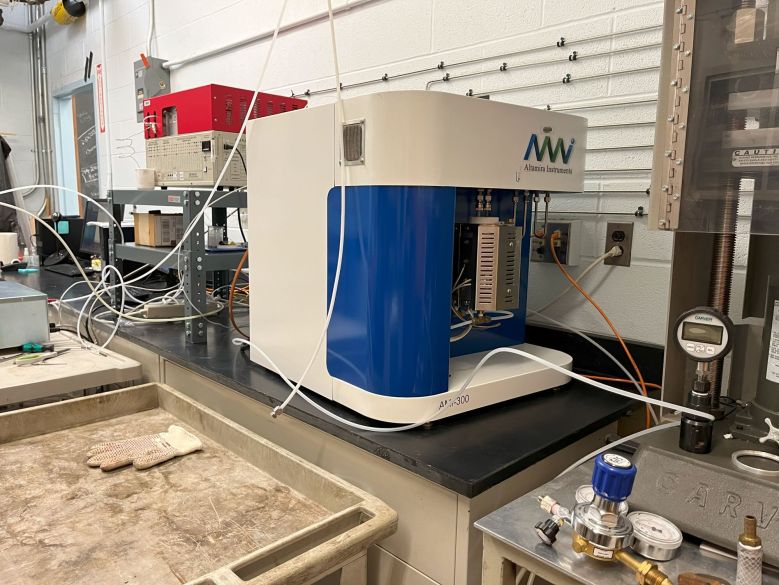
The tabletop version I saw is still “frontier technology,” Srinivasan cautioned, made possible by recent advances in catalyst efficiency. But it could be a good fit for smaller installations to catch methane leaking out of Pennsylvania’s many abandoned coal mines. Modular decomposers could convert those decentralized streams of intensely planet-warming gas into harmless carbon solids that can be used as industrial feedstocks.
Pittsburgh steel goes solar
The town of Leetsdale hugs the Ohio River north of Pittsburgh, surrounded by sprawling industrial complexes and freight lines. During World War II, Bethlehem Steel fashioned barges and landing craft there. Historians describe that war as a clash of steel that the U.S. won because its factories cranked out more tanks, planes, and ships than its opponents.
Most of those factories are long gone, but JM Steel, an affiliate of the century-old company Jennmar, took over a site in Leetsdale one year ago and reopened it with a new mission: bending steel to the will of the burgeoning solar industry. Its preliminary success shows how federal clean energy policy is breathing new life into Pennsylvania’s legacy industries — exactly what the hydrogen hubs are supposed to do.
When I rolled up to the riverside lot, the factory looked like it was fortified for some kind of invasion. Thirty-foot steel tubes had been trussed up by the dozen and stacked to form an impenetrable barricade taller than a person.
Pittsburgh native Chris Bartley led me through the steely labyrinth, explaining that these pipes were torque tubes ready to ship. His employer, Nextracker, uses the tubes to mount huge numbers of solar panels that can change their angle throughout the day.
Early in the solar revolution, developers installed panels in fixed positions, at what seemed like the most advantageous angle. Silicon Valley startup Nextracker revolutionized the market by attaching panels to trackers that follow the sun’s arc, and pivot away from dangers like hail or high wind. This innovation enhanced solar power output and made Nextracker one of cleantech’s clearest commercial successes: It went public in 2023 and now trades with a market cap over $5 billion. To supply its booming business, Nextracker enlists specialists like JM Steel to sculpt metal to its specifications.
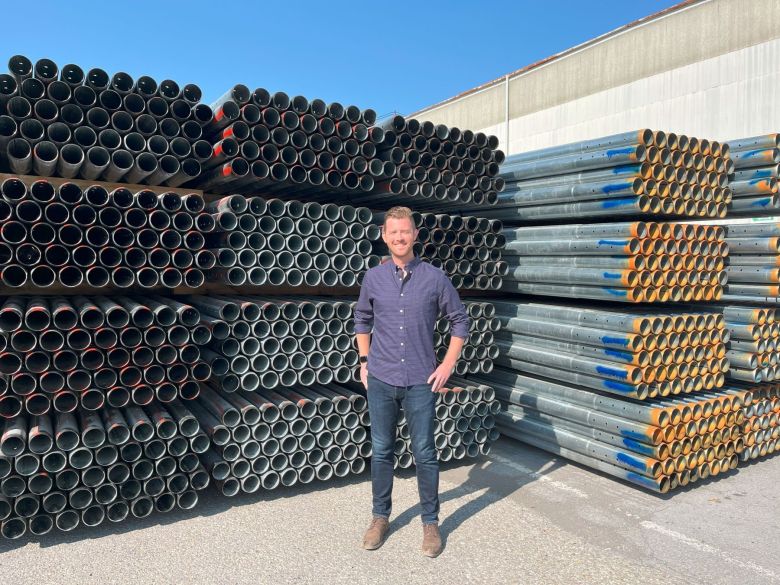
In a little meeting room off the factory floor, Negley Rodgers, who oversees plant operations for family-owned JM Steel, told me the plant ships an average of six truckloads of torque tubes per day — 350,000 torque tubes since last October. They go straight to solar plants in the region, where the tons of steel translate to megawatts of cheap, clean power rushing onto the grid.
We donned hard hats, earplugs, and orange scratch-resistant sleeves for my exposed forearms, then walked into the cavernous factory. First we saw the “master coils” of rolled-up flat steel that the company buys from domestic producers like Nucor and SDI. The coils don’t look overwhelmingly large, but are so heavy that flatbed trucks can carry only one at a time, Rodgers noted. The high-ceilinged factory has a built-in crane capable of lifting 40 tons to maneuver the coils into position.
Workers feed these coils into machines that use heat and immense force to roll the flat material into thick round pipes. Another station drills the holes that will attach the solar panels. JM adjusts the drilling arrangement for each project — some use bigger panels, some smaller, but the company can accommodate them all on the same production line.
Before Covid-19, Nextracker relied on a more typical globalized supply chain. Then CEO Dan Shugar decided to localize tracker production to where his customers operated around the world: Solar plants would get trackers made nearby, so nothing got stuck in port overseas. A couple of years later, the IRA sweetened the deal with meaningful financial incentives to produce solar-power components domestically.
The Inflation Reduction Act created an 87-cent-per-kilogram tax credit for torque tube manufacturing. Additionally, solar developers can access an extra 10 percent tax credit for their power plants by hitting a critical mass of domestic components, per an IRS rubric. Trackers include torque tubes, rails, controllers, and motors, Bartley explained; sourcing all those components in the U.S. unlocks a bonus, which nets 24.7 percent coverage for the overall solar project.
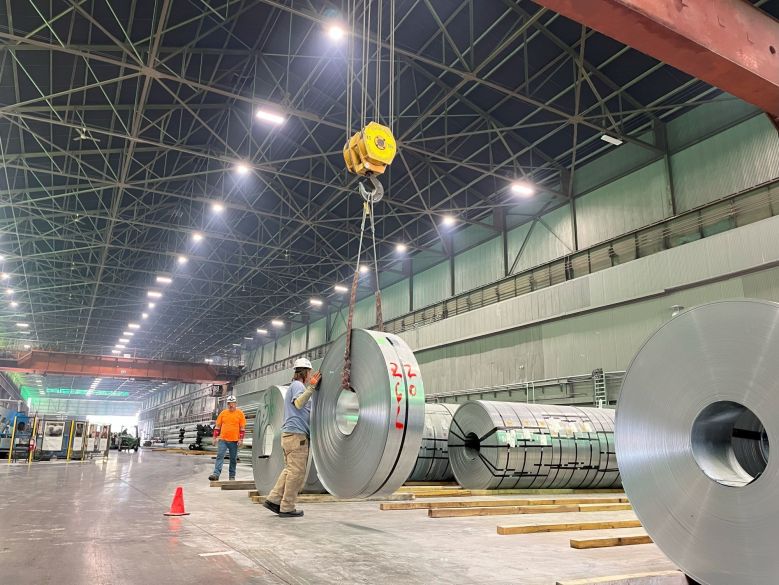
The exact level of domestic content varies by project, based on what a developer is looking for. A U.S.-made tracker creates flexibility for how the company sources other components while still meeting the IRS cutoff.
Conventional corporate wisdom long held that offshoring production to China cut costs and improved profits. Sourcing a 100 percent domestic tracker still adds a premium, Bartley said, but it’s already possible to make most of the system here without driving up cost.
“Looking at our cost of a tracker fully delivered to a job site, we’re seeing really competitive costs and pricing [while] making a significant part of the tracker domestically,” he said. “As time goes on, we’re expecting any sort of premium like that to go down, because we’re expanding capacity of these other components, like our electronic components.”
Part of that favorable comparison to foreign imports has to do with the inescapable heft of this product: “They’re not shipping nuts and bolts that they can pack into a tight box on a ship,” said Rodgers. “They’re shipping these large, 30-foot-long, five-inch diameter tubes that take up a massive amount of volume on a ship.”
Steel companies have opened 20 factory sites across the U.S. that exclusively produce torque tubes for Nextracker; the factories wouldn’t exist without the demand from the booming solar market. JM ships from Pittsburgh to places like Indiana, Illinois, and Tennessee, but business in Pennsylvania has been picking up, as evidenced by the blockbuster Mineral Basin Solar project. That one will put 400 megawatts on reclaimed mining land northeast of Pittsburgh. The power and its clean energy credits will actually flow to New York, but millions of dollars of lease payments and tax revenues will stay in the county.
For JM Steel, the imperative to decarbonize has given new urgency to the skills and products that Pittsburgh long excelled at. At the same time, U.S. Steel is trying to unload its flagship Pittsburgh steel plant to a Japanese company, arguing that it’s the only way to remain commercially viable. I asked Rodgers if that deal signaled the end of an era for American steelmakers.
“I can’t comment on that,” he said, referring to U.S. Steel’s position. “Just — manufacturing is still viable, and it’s still happening in the United States.”
Indeed, the growing pressure on big steel buyers to source lower-carbon or “green” steel could give U.S. companies an edge on overseas competition. The U.S. already uses a high proportion of electric arc furnaces to melt scrap metal into new products; those can run on clean electricity to further curb their carbon footprint. The industry is also exploring ways to decarbonize the carbon-intensive conversion of iron ores to metallic iron, by using clean hydrogen instead of coal. Pennsylvania doesn’t have any of those facilities operating yet — the world’s first large-scale commercial plant of this kind is under construction in Sweden. But the hubs aim to bring clean hydrogen supply to greater Pittsburgh, and the DOE has funded steel companies to build initial facilities to use it.
For now, JM Steel’s plant serves Nextracker’s needs with some 53 employees — a welcome addition, but not close to the scale of employment at the site in bygone decades. For clean energy buyers or green steel customers to make a mark on the regional economy, they’ll need to put many more people to work.
Reopening factories for battery breakthroughs
Solar panels planted on Pittsburgh steel clean up the grid during sunny hours. But as solar generation provides ever more electricity, new energy storage technologies will be needed to turn cheap renewables into round-the-clock power.
Federal policymakers hope to bring battery manufacturing back to the U.S. after China pulled far ahead in its capacity to make lithium-ion batteries. It’s extremely difficult to catch up to competitors who are already producing at tremendous scale — the recent financial struggles at Europe’s Northvolt attest to that. Pittsburgh, though, has become a hub for fabricating novel battery technologies that aren’t made anywhere else in the world, a risky strategy with the potential for a big payoff.
Habitually cash-strapped startup Eos makes zinc-based batteries at the junction of Turtle Creek and the Monongahela. For decades, Westinghouse built electrical generators on the site that powered the Hoover Dam and other icons of modern America. Nikola Tesla once toiled there, as did more than 20,000 workers in the plant’s heyday. But Westinghouse shuttered the Turtle Creek plant in 1988, gutting the economy of the surrounding Mon Valley.
Now Eos employs 300 people to manufacture energy storage in 150,000 square feet of the old Westinghouse complex. If the unconventional product takes off, Eos could expand and further boost the local economy — but that’s a big if.
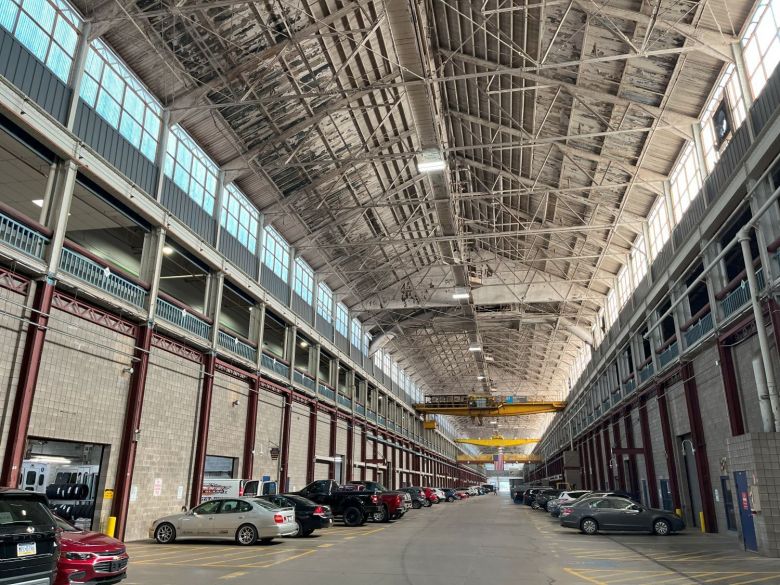
Eos has toiled, since 2008, to commercialize a new type of battery that could beat lithium-ion on fire safety and cost for longer-duration energy storage. Lithium-ion batteries almost always win customers looking to deliver stored power for four hours, and increasingly five or six. Beyond that, lithium-ion gets prohibitively expensive. Eos markets its batteries as capable of delivering power for three to 12 hours, which runs the gamut from the incumbent technology’s sweet spot to a storage duration that few customers have ever purchased.
That’s a tough market to break into, and Eos survived its first decade with little commercial traction to show for it. In 2019, the board brought in a new management team, a crew of GE veterans, led by CEO Joe Mastrangelo. He stopped outsourcing fabrication to contractors in China and localized production in Pittsburgh.
I met Mastrangelo in a conference room above the factory. He wore thick-framed glasses and a company hoodie, lime-green logo on forest green. The outfit reminded me of Pennsylvania Sen. John Fetterman (D), who famously bucked tradition and wore hoodies in the halls of power. Mastrangelo pointed out that Fetterman lived a mile down the street in Braddock, where he used to be mayor, in a house overlooking the U.S. Steel plant.
Reshoring the supply chain surely saved Eos during Covid-19, Mastrangelo explained. If production had frozen for a couple of years when China closed its factories, “we would have been done.” Eos also avoided under-discussed costs of offshoring, like lengthy, expensive flights to China to check on manufacturing progress. Eos built the factory with its own money — a rare feat in the incentive-happy cleantech factory boom — but found itself ready to capitalize on the domestic manufacturing incentives created by the 2022 Inflation Reduction Act.
Downstairs, I saw the fully automated line that Eos installed in June, capable of producing 1.2 gigawatt-hours per year. The machinery sat inside a wire-fenced perimeter. A succession of robots picked up gray plastic boxes, stocked them with Eos’ proprietary electrodes, then injected them with a liquid electrolyte in two carefully calibrated gushes, to prevent it from foaming and spilling.
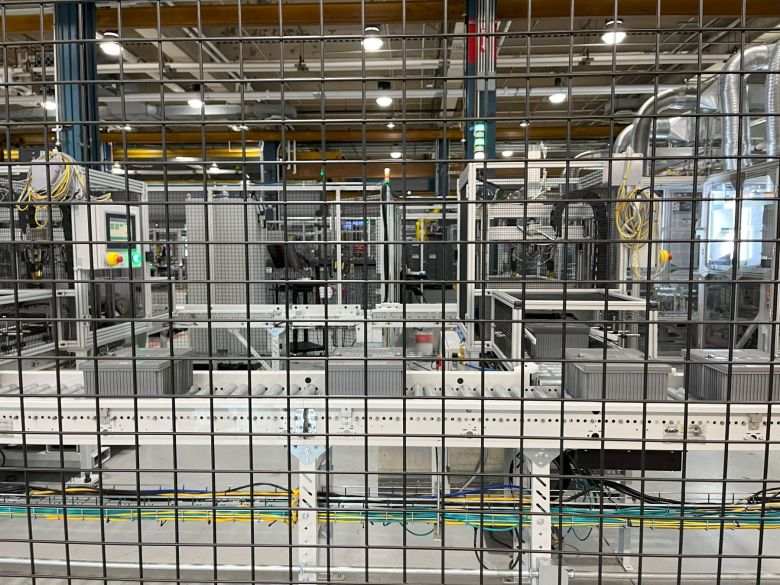
Eos employees patrolled the perimeter, many of them wearing the same green-on-green hoodie as their CEO. Their job was to keep the machines running: When a robot got confused, or the operating controls hit a glitch, alarms sounded and the technicians hurried over. This happened throughout my tour; as I’d seen in other cleantech factories, “full automation” is more aspirational than descriptive.
The bustling factory embodies the theory that Pennsylvania’s abandoned factories can spring to life to serve the material needs of the clean energy revolution. Pennsylvania’s minimum wage is $7.25 an hour, but Eos’ average wage is above $20, Mastrangelo said. Employees get a 3 percent direct contribution to their 401(k), and regular grants of company stock (Eos went public in 2020 via a special-purpose acquisition company). “We also view this as a massive opportunity for everybody to get wealth creation,” Mastrangelo said.
But startups are unsteady vessels for economic growth, and Eos’ finances are more unstable than most.
Last year, Eos spent $169 million to make $16.4 million in revenue. It’s normal for a startup to lose money while ramping up commercial production. But Eos’ public listing failed to net enough money to fully fund the buildout, so it has repeatedly beseeched investors for more infusions (like $100 million from Koch in 2021). This summer, Nasdaq nearly booted Eos for trading below $1 a share for too long.
Mastrangelo escaped that ignominy by closing a $325 million commitment from a domestic supply chain–focused fund at private equity firm Cerberus, on June 24, in the form of a loan with stock warrants (and surely one or two strings attached). Since then, Eos’ share price soared all the way past $3.
With this private-equity lifeline in hand, Mastrangelo has faith that demand for his unusual batteries will pick up. Eos is commissioning a 35-megawatt-hour storage system serving a microgrid on a Native American reservation in Northern California, funded by a California Energy Commission grant for long-duration storage. That customer already signed up for an expansion to 60 megawatt-hours. Eos also delivered a 10-megawatt/4-megawatt-hour standalone system in Texas for Pittsburgh-based developer IEP. These are small potatoes compared with lithium-ion battery projects, but substantial for the ragtag category of erstwhile lithium alternatives.
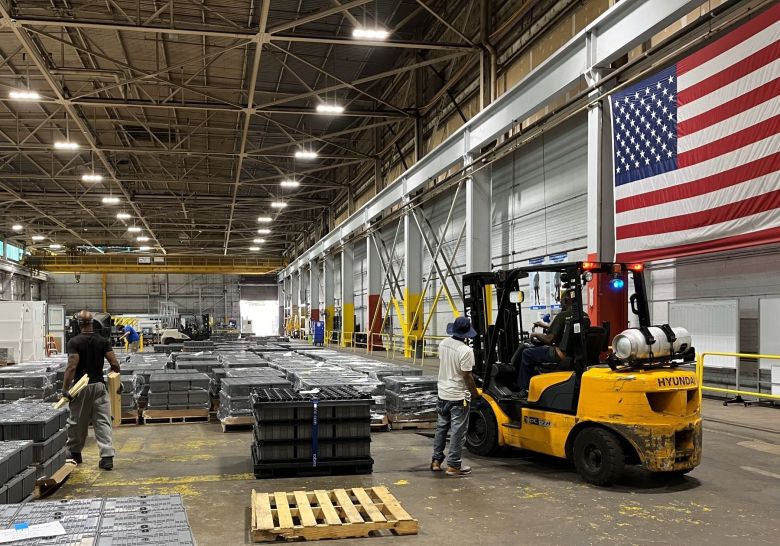
“The one thing we’ve always told everybody is, the market needs a product like ours,” Mastrangelo said. “We continue to do things that haven’t been done before, and we just have to keep executing on our plan, and eventually the market will reward performance.”
An even more unusual battery is being fabricated about 36 miles west of downtown Pittsburgh. This one, designed by Form Energy, uses iron as a cheap storage material and promises to deliver clean power for up to 100 hours, far beyond what lithium-ion batteries can handle affordably. Unlike Eos, Form had no trouble lining up venture capital investment and hundreds of millions of state and federal dollars to fund its buildout; in fact, the company just closed another $405 million equity investment on October 9.
Form took barely a year to transform the slag-studded field of an abandoned steel mill into a gleaming new factory. Its white outer wall rises like a curtain to reveal a transparent entranceway, highlighted in the company’s trademark orange. Inside, an airy vestibule lined with greenery and an exhibit on the town’s industrial history gives way to the 550,000-square-foot production zone.
“We wanted it to be an inviting place,” CEO Mateo Jaramillo told me from a glass room on the mezzanine level, suspended above the factory floor. “It should feel like innovation. It should feel like something new. It should feel like a safe, clean place to work.”
Form developed its technology at labs near Berkeley and MIT, then expanded to a facility in the tiny town of Eighty Four, outside Pittsburgh. The company doubled down on the region for its full-fledged factory, and landed several hundred million dollars in state incentives from West Virginia to locate in that state, in the former steel town of Weirton. Pittsburgh is the closest big city to Weirton, and many of the workers commute from Pennsylvania. The success of this factory, like JM Steel or Eos, speaks to Appalachia’s ability to seize the clean energy era for its economic revival.
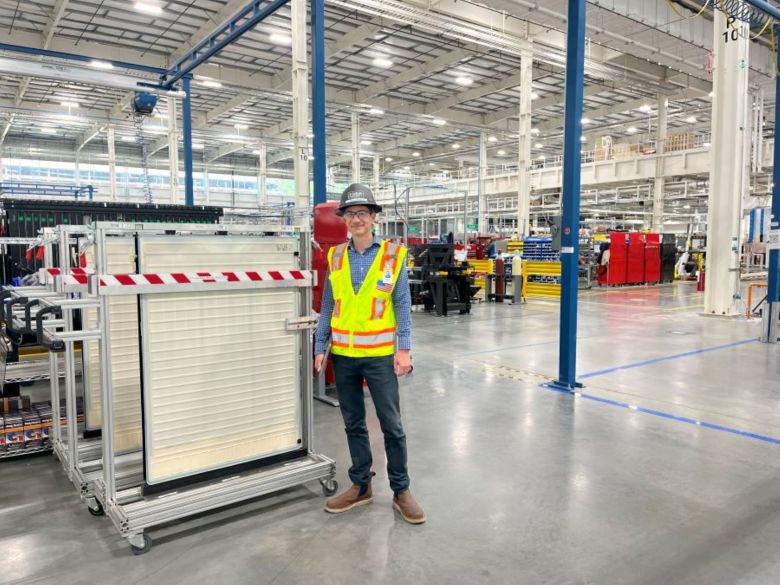
Form chose a factory site rich in symbolic resonance: The startup is claiming a spot in the industrial landscape of the Ohio River Valley, creating jobs where the legacy industries seem capable only of shedding them (steel giant Cleveland-Cliffs was clinging on next door, but idled that operation in April; the company hopes to reopen the site to make electrical transformers starting in 2026). Form even uses iron, the same material that, with coal, fueled the region’s steel boom.
These layers of narrative meaning play swimmingly at ribbon cuttings, but I was curious what they offer once the tax incentives are secured. Jaramillo acknowledged that “grand poetry” isn’t what makes batteries.
“On the day-to-day, we don’t think a lot about the precise industrial legacy — we’ve got a job to do, so we go do the job,” Jaramillo said. “That’s probably the most direct legacy, is people who are really oriented on taking care of the job.”
Form has seen “huge demand” for open positions, and Jaramillo reported no problems finding the quality and number of workers needed. The company promised the state of West Virginia that salaries will average at least $63,000 per year — well above minimum wage, and substantial in a region with low costs of living.
So far, Form runs a single shift per day, for 10 or 12 hours. Some 300 people work at the factory, but that should grow to 750 in a few years, Jaramillo said. The plan is to quintuple capacity from 2025 to 2026, and quadruple it again from 2026 to 2027, at which point the factory will make 500 megawatts per year; for the long-duration format, that translates to 50,000 megawatt-hours.
The Pittsburgh metro area scores quite high for its capability to manufacture a range of clean energy technologies, per economic development analysis by climate think tank RMI.
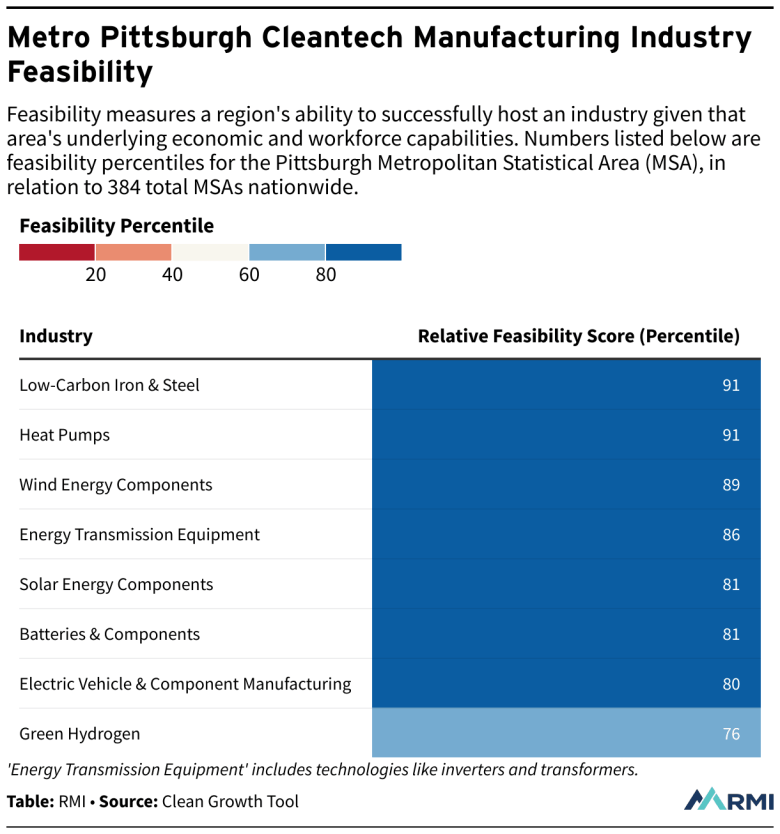
Eos and Form were the first major battery makers to turn that potential into real jobs. Neither technology has been deployed on the grid in sufficient scale to ensure its longevity as a climate solution; that work lies ahead of them. But they demonstrate that it’s possible for the decarbonization mission to reanimate long-abandoned factories and put Pennsylvania’s workers back on the line.
Over two centuries, Pennsylvania’s energy resources brought clear gains in jobs and wealth. The nascent industrial decarbonization transition needs many more years of dedicated federal and local support before it can credibly substitute for the legacy energy economy. That’s not a convenient timetable for Democrats trying to make the case now for a Harris administration, and yet the outcome of the election will have an enormous impact on whether that support continues.


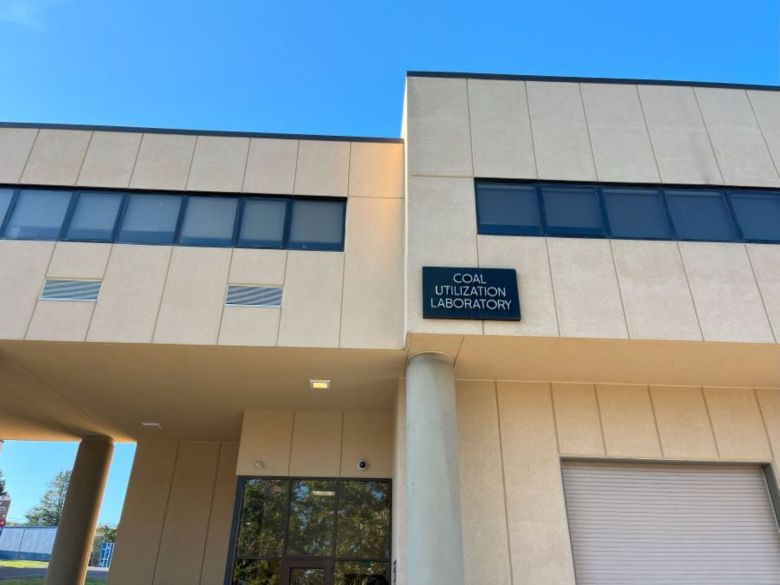


![Tesla reviewer breaks down the price of owning an EV versus a gas car in the US: 'Real costs after one year [of] ownership'](https://energynews.today/wp-content/uploads/2023/06/yahoo_news_en-US_s_f_p_168x21_news-90x21.png)






